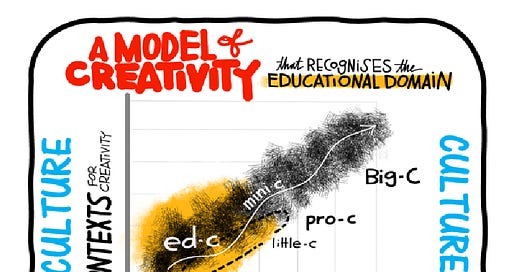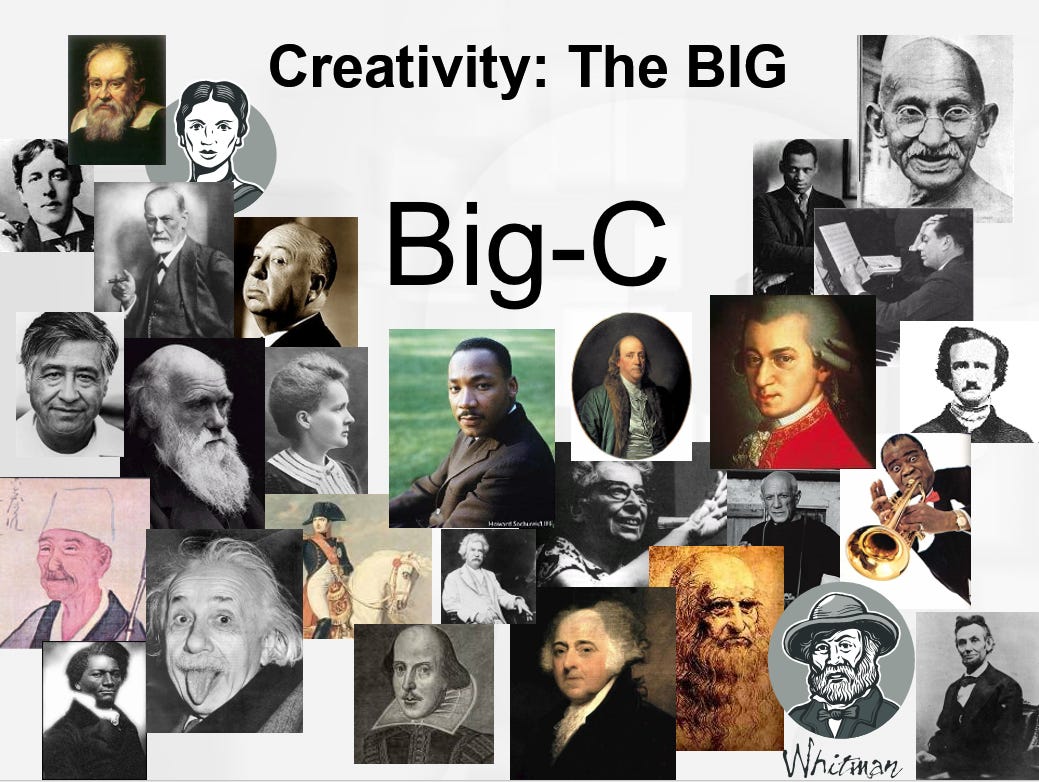If you seek unconventional insights on well-being and optimal human functioning, subscribe today. Provoked has readers in all 50 US states + 102 countries, and it was pretty, pretty cool being named a Substack bestseller!
Yesterday, I wrote on three psychological barriers to creativity: inertia, creative mortification, and fear of emotional contrasts. If you value the creative process, it’s worth knowing these stumbling blocks - click here.
I mentioned how it’s problematic when someone says everyone is creative, and anyone who tries to be creative is creative. Yes, this is inclusive. Yes, this might make people feel great in the moment. But this also means the word is useless. It then becomes an unnecessary contrast as opposed to a specific designation of how a product is particularly high in novelty + usefulness.
Just because you care about the work doesn’t mean you produced something creative.
Effort expenditure has no bearing on the creativity of what you do.
Executing a task well might mean you performed well, but this is independent of whether what you did is creative.
And yet, there is some merit to the idea that maybe our threshold is unnecessarily high in determining whether someone is a creative person, someone produced a creative product, and a creative process occurred.
To better understand creativity, consider a multi-dimensional approach.
In the realm of creativity, there are numerous ways to interpret and categorize innovative sparks that occur in our lives. From the grand, world-changing ideas of history's eminent figures, to the everyday problem-solving of ordinary individuals, creativity is vast and varied. To better understand this spectrum, let's explore the "Four C model of Creativity.”" proposed by my beloved collaborator James Kaufman and Ronald Beghetto in 2009. Enough of the overly general thoughts on creativity. Use this model to differentiate and appreciate the levels of creativity.
A model illustrated well by Slta Magnuson:
Arguably, there are 4 forms of creativity, each influenced by the social norms of the culture you live in. Larger forms of creativity are more harshly judged BUT are recognized and appreciated by far more people in a wider range of situations. Smaller forms of creativity are easier to obtain, and often only loosely connected to the larger culture. This is captured in the illustration above.
Level 1: The Smallest Unit
Let's start with the smallest unit, what they call "mini-c" creativity. Picture a child, crayon in hand, sketching their first car on a piece of paper. It's not a Picasso or a Rembrandt, but it's the child's unique interpretation of what a car looks like. This is mini-c creativity - the personal and meaningful insights that arise from learning and exploring new concepts.
It's the "aha" moments you have when you understand something new or see a problem in a different light. It's creativity on a personal level. New ways to pursue your life, for example. What I refer to as Niche Carvers - take a quiz to uncover and understand your own Rebel Archetype - here.
Only a miniscule level of judgment is offered because the stakes are small. But even still, creativity is understood from the perspective of the person and product.
Level 2: A Little Unit
Now, imagine a father, fueled by a desire to help his daughter win a local gravity racer championship. She's not an engineer or a professional designer, but she finds a unique way to build a racer that's faster, sleeker, and better than the rest. This is an example of "little-c" creativity, where ordinary people come up with novel solutions or ideas in their everyday lives.
This is the creativity use when you come up with a new recipe, find a new route to work, or figure out how to discuss relational problems with a family member.
It's creativity that's useful and novel on a small scale. Remember, creativity is still a specific act. It not mere effort or performance.
Level 3: Expertise Comes Into Play
Moving up the ladder, we reach "Pro-c" creativity. This is the realm of professionals, the experts who honed their skills and knowledge over years of practice. Consider a professional car designer, meticulously crafting blueprints for a new model, blending aesthetics and functionality in a way that's innovative yet practical. Or solving the problem of when approached by five attackers or someone taller who wants to harm you
It's creativity that contributes to a field but doesn't necessarily redefine it. This level of creativity is beyond the reach of most hobbyists, but it still doesn't touch the heights of the creative mountain.
Level 4: Legendary Creativity
That peak is reserved for "Big-C" creativity, the domain of eminent figures whose creative outputs have a profound and lasting impact on society. Think of Battista Pininfarina, the legendary designer behind iconic Italian sports cars. His designs didn't just push the boundaries of automotive design; they redefined them, leaving a legacy that continues to inspire car enthusiasts around the world.
Think of Darwin, Shakespeare, and Montessori. Their creativity changed the world in some way. You know the names of these people because their creative products improve our lives and/or serve as inspiration for progress. Here’s an image to initiate conversation on who counts, when, and why:
Coda
As we navigate through life, many of us experience moments of creativity that along spectrums. Whether we're sketching our first car, building a gravity racer, designing a new model, or reshaping an industry, each act of creativity is a testament to unique Talents x Knowledge x Strengths to envision and create.
The Four C Model allows for intricate details of how and when people are creative. However, it still hinges on the definition of creativity. And creativity is not mere effort or desire. Creativity is not the same as executing instructions well and performing well. If we don't differentiate, we do a disservice to understanding the complexity of human behavior and possibility.
Which level of creativity did you lean towards yesterday?
What do you want to push towards today and tomorrow?
Keep the conversation going by connecting with me on: LinkedIn. Please share this with others who care about creativity.
Extra Curiosities
If you relish the science of creativity as much as I do, make sure to read the Substacks on this topic including
and andAs for podcasts, I loved this wide ranging conversation on leadership, motivations, strengths, social norms, and non-conformity. This kind of wacky unpredictable dialogue is why I do media interviews. Enjoy watching this episode of The Show Your Value Podcast. If you prefer to listen, use this Spotify link - here.
Todd B. Kashdan is an author of several books including The Upside of Your Dark Side (Penguin) and The Art of Insubordination: How to Dissent and Defy Effectively (Avery/Penguin) and Professor of Psychology and Leader of The Well-Being Laboratory at George Mason University.
Read Past Issues Here Including:
Why Your Kid is Not Creative
Provoked has readers in all 50 US states + 102 countries. If you seek unconventional insights on well-being and optimal human functioning, subscribe today. Access prior issues on creativity such as 6 crippling fears in groups, pain and creativity, the






I really enjoy where this conversation has taken us.
Personally, I think that the little c is a vital source of creativity, since that’s where personal growth and evolution occurs. We dare to break our own personal mundane patterns to try something “new to us”, this generates ripples of confidence, learning, and further exploration.
This then changes how we interact with peers and family; and how they react to us. Just because it lacks societal scale doesn’t mean that is not monumental.
Here’s my level 4 creative genius: Jacob Collier. He is wise behind his years. He is deeply attuned to what he calls “the infinity of choices.” https://youtu.be/eVkaNI17ZoI?si=4-RSko2oEeVMHBdp